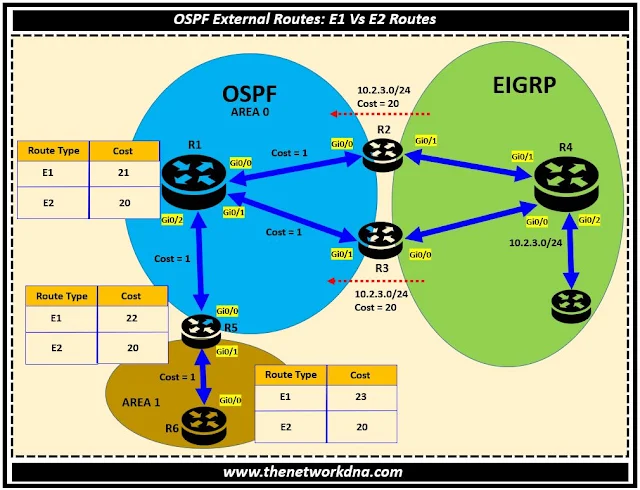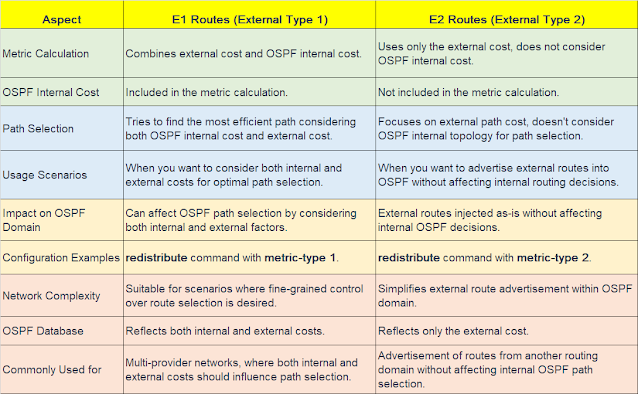OSPF External Routes: E1 Vs E2 Routes
OSPF External Routes: E1 Vs E2 Routes
 |
| Fig 1.1- OSPF External Routes: E1 Vs E2 Routes |
External Routes (E1 and E2 routes) are used in OSPF (Open Shortest Path First) routing protocol to represent routes learned from outside OSPF, typically from another routing protocol. OSPF injects these routes into the domain. OSPF calculates and propagates the cost (metric) of external routes differently for E1 and E2 routes.
OSPF E1 Routes ( External Type 1)
Both the OSPF internal cost and the external cost are taken into account by E1 routes. In other words, E1 routes account for the cost of both the OSPF connections and the external path. When computing the overall metric, the cost of the external path is added to the cost of the OSPF connections.
This strategy seeks to identify the most effective course while taking into account both internal and external OSPF costs.
In other words, E1 route is an external route that takes the combined costs of all paths in account when it is routed through the OSPF domain. This permits you the ability to preference the path with the best route to the exit point (closest exit. Hot potato). In other, words, as far as OSPF considers it, the external metric useful to the route and the internal metrics are the same.
So if you see the above scenario, the calculation for the route 10.2.3.0/24 will be like as
On router R1, Cost of E1 routes will be (Cost of redistribution on R3/R2 = 20) + (Cost of R3/R2 to R1 = 1). So total cost will be = 21
On router R5, Cost of E1 routes will be (Cost of redistribution on R3/R2 = 20) + (Cost of R3/R2 to R1 = 1) + (Cost of R1 to R5 = 1). So total cost will be = 22
On router R6, Cost of E1 routes will be (Cost of redistribution on R3/R2 = 20) + (Cost of R3/R2 to R1 = 1) + (Cost of R1 to R5 = 1) + (Cost of R5 to R6 = 1) . So total cost will be = 23
OSPF E2 Routes ( External Type 2)
The external cost is the only consideration for E2 routes. The OSPF internal cost is not included in the measure. The cost of the external path is employed without taking into account the internal OSPF topology.
When you wish to advertise external routes into the OSPF domain without affecting internal OSPF routing choices, E2 routes are frequently employed.
In other words, E2 route is an external route that only takes the redistributed metric (seed metric) in account when being communicated. In the other words you can say that this route is "an order of magnitude larger" than any other external route. This is to say that the E2's redistributed metric (seed metric) is not equivalent to the metrics used in the OSPF domain and should be measured after all routes that are E1 routes.
So whether it is On router R1, R5 or R6, Cost of E2 routes will be (Cost of redistribution on R3/R2 = 20). So total cost on each router still be = 20
Comparing OSPF EOSPF E2 Routes ( External Type 2)
 |
| Fig 1.2- OSPF E1 Vs E2 routes |
The OSPF default routes are identical to other default routes. Type-5 LSAs are often flooded. You can choose to originate a default route only if one exists in the routing table (excluding the always command in your default-information originate statement) or to originate a default route regardless of whether a default route exists in the routing table of the local router (default-information originate always).
Continue Reading...
- OSPF Show Commands on Cisco, Juniper, Huawei, HP and Arista Networks devices
- How to Optimize Your MPLS VPN with OSPF Sham-Link
- OSPF protocol : OSPF Packet Types
- OSPF NSSA Area introduction and Configuration
- Facts about DR and BDR selection in OSPF
- OSPF and BGP configuration setup on a vEdge Router
- OSPF Configuration Guide : OSPF Distance External Command Behavior
- A quick difference: OSPF Vs IS-IS Dynamic Routing Protocol
- Routing: Configuration OSPF To Filter Type-5 LSAs
- Introduction to OSPFv3 AS External LSA Route Calculation
- Differences between OSPFv3 and OSPFv2
- OSPF Over non-Broadcast Networks ( NBMA) basics and Configuration
- OSPF Configurations in Huawei Routers
- Quick tips to OSPF Routing Protocol for Network Engineers
- OSPF Basic configuration Step by step on Cisco Routers
- OSPF Basics : Simple points to study
- OSPF prefix-suppression- Configurations and Verification
- OSPF LSA-ID Conflict : %OSPF-4-CONFLICTING_LSAID
- Cisco IOS-XE: OSPF stuck in INIT - LLS TLV
- Configure Redistribution of iBGP Routes Into OSPF
- Cisco and Juniper Routers : OSPF point to multipoint configurations







